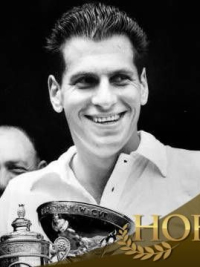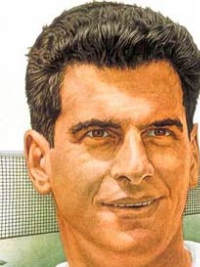Dick Savitt
Full name: Richard Savitt
Nickname: Dick
Nickname: Dick
| Born |
Subscribe now
This information and data is not available because you are not our subscriber yet.
Please click here and get full access to the entire database! |
|---|---|
| Class of HOF | |
| Height | |
| Weight | |
| Plays | |
| Bio | Savitt was mostly ranked World No. 2 the same year behind fellow amateur Frank Sedgman,though was declared World No. 1 by The New York Times and The Owosso Argus-Press following his Wimbledon victory. He retired the following year. Savitt is Jewish, and was born in Bayonne, New Jersey. He taught himself tennis at the age of 14, but never took a tennis lesson in his life. The self-taught Savitt played tennis well enough, however, to make the finals of the New Jersey Boys Championship and, for two years afterward, the National Boys Tennis Tournament before moving up to the junior ranks. His first love was basketball, though, and when his family moved to Texas, he was an All-State forward and a co-captain of his El Paso, Texas high school basketball team in 1944. In 1945 Savitt entered the Navy, and played on a service basketball team. Despite considering tennis his "second" sport after basketball, he won the Texas University Interscholastic League boys singles championship in 1944–45. Nationally he was the 8th-ranked junior tennis player, and the 17th-ranked amateur overall. In 1946, Cornell University offered Savitt a basketball scholarship. He attended Cornell, where he majored in Economics, was a member of the Pi Lambda Phi fraternity, and was elected a member of the Sphinx Head Society. However, two injuries, one to his knee, curtailed his basketball career. Savitt resumed playing tennis. He became Cornell's tennis team captain, # 1 singles and doubles player, and the NCAA champion. In 1947 he was ranked # 26 in the U.S., and two years later he was ranked # 17. In both 1949 and 1950, as a junior and a senior, he won the Eastern Intercollegiate Tournament, and he won the doubles title with Leonard Steiner from 1948–50. In 1950 he also won the East Clay Court Tournament and the New York State Tournament. He was 57–2 in singles for his college career, and graduated in June 1950. Savitt ranked in the world's top 10 four times between 1951 and 1957 (# 2 in 1951); and in the U.S. top 10 six times between 1950 and 1959. That was despite the fact that Savitt did not compete in 1953–55. Among Savitt's major victories were the 1951 Wimbledon singles championship and the 1951 Australian Open. He also won the 1952, 1958, and 1961 USLTA National Indoor Championships, becoming the first player to win that crown three times, and won the Italian doubles and the Canadian singles and doubles championships. Without any coaching, in 1950 Savitt reached the U. S. Tennis Championship semifinals at Forest Hills, losing to Art Larsen. In 1951, at the age of 24, Savitt won the Wimbledon Singles Championship. Along the way he beat Larsen, the # 1 US player, in straight sets, and Herbert Flam, the # 2 US player. He won the Australian Open Singles title in straight sets in the 61-minute final.He became the first American since Don Budge, 13 years earlier, to win both Wimbledon and the Australian Open in one season. Savitt also became the first Jewish player to win either tournament. In the Jewish parts of North London, Savitt recalled, "Nobody knew tennis there, but after I won people started picking up rackets". In addition, he became the first Jewish athlete to appear on the cover of Time magazine. The significance of a Jewish tennis player succeeding was rooted in the fact that tennis was still at the time primarily a country club sport, and many country clubs often did not allow Jews in as members and did not allow them to use their courts. This, in turn, kept many Jewish tennis players from obtaining the training they needed to compete at the highest levels. Savitt was ranked 2nd in the world in 1951.He was also ranked the # 1 player on the United States Davis Cup Team He made it to the semi-finals of the Australian Open in January 1952. In February 1952 he beat Bill Talbert 6-4, 6-3, 6-4 to win the U.S. National Indoor championship. In September 1952, he beat Art Larsen 10-8, 6-3, 6-4 to win the Pacific Coast men's singles tennis championship. Although at the top of his game, and only 25 years old, Savitt abruptly retired from competitive tennis after winning the 1952 U.S. National Indoor Singles Championships. He never publicly discussed the reason for his sudden retirement, but it was considered most likely the result of his snub by the US Davis Cup coach. Savitt had played and won his three early 1951 Cup matches, winning 9 of 10 sets, en route to leading the American team into the championship round against Australia. Allison Danzig, the senior American tennis writer, called him America's best hope for victory. American Davis Cup coach Frank Shields, however, did not permit him to compete against the Aussies whom, only months earlier, he had dominated at Wimbledon and in Australia. He had trounced Australia's top seed Ken McGregor in three straight sets to win at Wimbledon, and won the Australian Singles championship, becoming the first non-Aussie to win that title in 13 years. He had also defeated Australia's best other player, Frank Sedgman, 6–3, 2–6, 6–3, 6–1 in the same tournament. Ted Schroeder, who had lost all three of his Davis Cup matches while losing 9 out of 10 sets in the process the year before and who was in semi-retirement, was chosen by Shield instead. Five of the top ten players in the U.S. publicly accused Shield of "obvious prejudice" in his choosing the team. Without Savitt playing singles, and with Schroder losing two of his three matches, the United States lost the 1951 Davis Cup to Australia. The controversy spilled over into the next year, when the 1951 national rankings were bitterly debated at the January 1952 U.S. Lawn Tennis Association annual meeting. Members of the Association's Eastern, New England, Southern, Florida, and Texas delegations, whose chief spokesman was Gardnar Mulloy, were in favor of Savitt being named the # 1 tennis player in the U.S. However, Frank Shields attacked Savitt in a "biting", "unprecedented" speech, which observers said swung the vote against Savitt. As it was reported by Time magazine, "the loudest talker was Frank Shields, non-playing captain of the losing U.S. Davis Cup team. Shields had ignored Savitt in the Davis Cup matches, had put his confidence in aging (30) Ted Schroeder ... who turned out to be the goat of the series. Shields was intent on keeping Savitt ranked ... at No. 3. Cried Shields: 'Never once in the past three months has Savitt looked like a champion. Not only that, but he was not the most cooperative player in the world while we were in Australia, and his sounding off brought discredit to the game. He was not a credit either as a player or a representative of America.'" Don McNeill, the 1940 U.S. champion, answered Shields's outburst by pointing out that players are ranked on their tennis ability, that personal prejudice should have nothing to do with ranking, and that Shields' remarks were "uncalled for". That met with "resounding applause" from the delegates. After the heated 5-hour session, one of the longest in U.S.L.T.A. history, President Russell Kingman called Shields's outburst "most unseemly."Australian Davis Cup team Harry Hopman called his arguments as to why Savitt should not be ranked # 1 "weak". Still, a never-before-required proxy vote was needed to decide the # 1 spot. Savitt was ranked the # 2 player in the U.S. by the U.S. Lawn Tennis Association, behind Vic Seixas and directly ahead of Tony Trabert. In February 1952, a distraught Savitt announced that he would play only one more tournament, the National Indoor Championships, and then retire from tournament tennis—at age 25. As his farewell statement, Savitt won the championship. Savitt returned to the competitive tennis scene part-time in 1956, and though his limited tournament competition prevented him from receiving an official ranking, he was nonetheless considered the number one player in the United States. In 1958, Savitt moved back to New York for business reasons and launched a part-time comeback in tennis. That year, he won his second National Indoors title, and in 1961 he captured his third—while remaining a weekend player. In 1981, he and his son, Robert, won the U.S. Father-Son doubles title. Tall and rangy, Savitt was an all-court player who possessed an immaculately produced backhand that was an essential tool in his success. From the back of the court, he could hold his own with anyone. In his prime, Savitt was considered the greatest back-court player in the game, with the hardest ground strokes.He also had a booming serve. He was a strikingly intense competitor and an earnest craftsman. His contemporaries described him as almost driven, a man who hated to lose. In 1961, he won gold medals in both singles and doubles (with Mike Franks) at the 1961 Maccabiah Games in Israel, the third-largest sporting event in the world. He was also very active in the Maccabi movement. Savitt in addition helped develop the Israel Tennis Centers, beginning in 1973. In 1998, he was the ITA overseas tennis director. In his 2007 book The Big Book of Jewish Sports Heroes: An Illustrated Compendium of Sports History and The 150 Greatest Jewish Sports Stars, author Peter S. Horvitz ranked Savitt the 9th-greatest Jewish athlete of all time. Dick was inducted into the International Tennis Hall of Fame in 1976 and into the International Jewish Sports Hall of Fame in 1979. Although he was inducted into the Intercollegiate Tennis Association Men's Collegiate Tennis Hall of Fame in 1986 Savitt was inducted into the National Jewish Sports Hall of Fame in 1998, and into the USTA Eastern Tennis Hall of Fame in 1999. He is also enshrined in the National Jewish American Sports Hall of Fame and into the Cornell University Athletic Hall of Fame in 1978. After his tennis career, he entered the oil business in Louisiana, then worked for Lehman Brothers on Wall Street, and in 1985 joined Schroders. |
| Misc | Subscribe now |
| Tournament | AO | RG | W | US | Win-Loss |
|---|---|---|---|---|---|
|
Subscribe now
This information and data is not available because you are not our subscriber yet.
Please click here and get full access to the entire database! |
|||||

